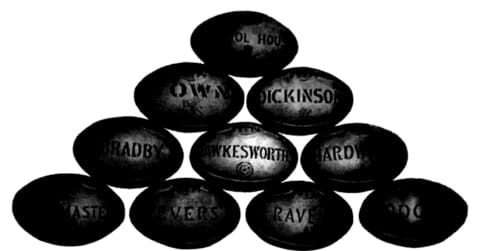(We are delighted to have Gilbert products available in the U.S. at World Rugby Shop. Shop all Gilbert Rugby Balls Here)
GILBERT RUGBY BALLS: THE MAKING OF AN ICON
Beginnings: Gilbert
Football in the town of Rugby was always unique. Before it was referred to simply as “Rugby”, it was a brand of football unique to the area. Points were scored by kicking the ball over the crossbar instead of into the goal. The shape of the ball, unlike any other of its time, was essential to the development of the game, and Gilbert was where it all started.
How the Early Days Shaped the Game
“Place-kicking and drop-kicking were therefore very important features of the game in the early days, and it is probably due to these two features that we get the oval ball -- the shape being suggested in the first instance by the shape of pig’s bladders.”
Pictured below are two variations of balls used around the 1960s. Their unique shape meant they could be kicked in some instances seventy yards or more, fueling that focus on scoring via place-kicks and drop-kicks. These examples are very different from the ball we know today, so how did the ball's shape develop into the one we know and love?

The Ball Evolves
A variety of factors contributed to the evolution of the rugby ball shape, but one of the most notable had to do with health concerns for the ball’s creators like Gilbert. Pig bladders were blown up in their “green state” using the stem of a clay pipe. Since the pump had not yet been invented, lung power was the only means by which to blow up the balls. In fact, William Gilbert became famous for his lung power. Blowing up pig bladders using one's lungs, however, presented a real danger. As you can imagine, pig bladders were not the most sterile of inflatables and it was not unheard of to contract lung diseases from them. At the time, this could very well be a death sentence for anyone unlucky enough to fall ill. Evolution quickly became necessary for the future of the game. First came the rubber bladder to replace the pig bladder, but it was soon deemed too difficult to blow up. After seeing an ear syringe, Richard Lindon, the inventor of the rubber bladder, took the same basic design and created a hand air pump from which the standard for inflating balls for decades to come was invented.

Pictured above are balls from 1922 made for the houses of Rugby School. Rubber offered a much more pliable option than pig bladder, allowing the ball’s form to change with the game. It is difficult to pin down exactly when the ball shifted, although it was certainly after rubber bladders came into circulation. William Gilbert marks the date around 1875, but we know for sure it was before 1892 when the first official regulation on rugby ball sizes came into existence. As the game developed, it began to focus more on the elements of handling and passing, so the ball adapted to that as well. Moving from its more spherical shape to the shape we recognize today strengthened the catching and passing elements of the game, making it also look more like the action we see on the pitch today.
From Rugby to Across the Globe
As the game changed, so did its ball and vice versa. Each was integral to the development of the other, constantly adapting to the ever-changing desires of the public, who loved this game so much. What started in a little town in England made its way around the world, with each nation creating is own unique nuances to their brand of rugby. William Gilbert marveled at the addresses from different nations as he wrote them on boxes full of Gilbert rugby balls---A little shop in England shipping out leather balls to far away places like New Zealand and Samoa. It was a wonder. This is the beauty of sport seen through the lens of rugby - while language barriers and physical distance threaten to divide, a simple rugby ball has been able to unify so many across the globe.

